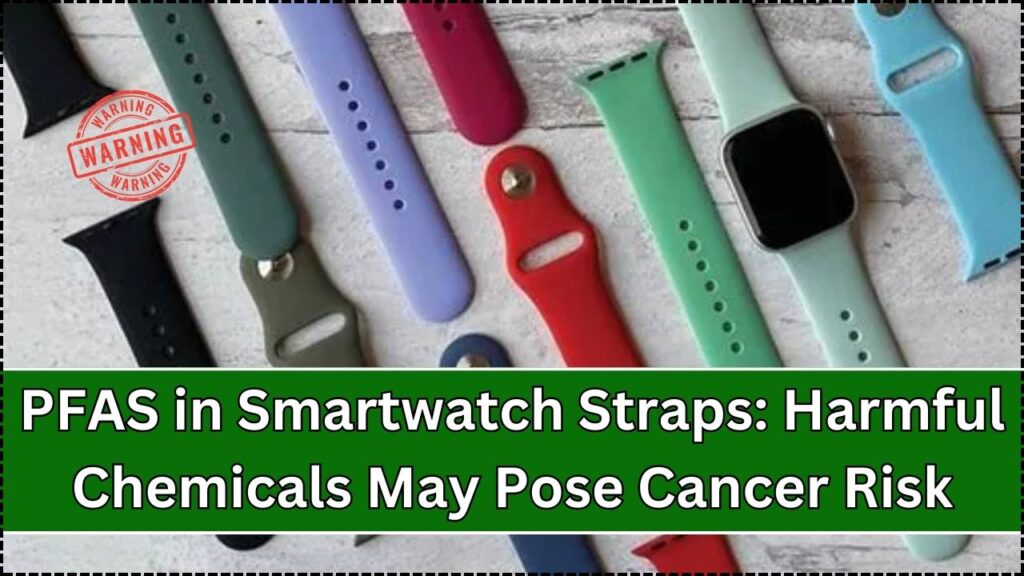
PFAS in Smartwatch Straps: Smartwatches and fitness trackers have become indispensable in modern life, helping us monitor everything from heart rate to daily steps. But a recent study has revealed alarming findings about the materials used in some of these popular wearable devices. Researchers found that smartwatch straps made with PFAS (per- and polyfluoroalkyl substances) might pose significant health risks, including a potential link to cancer.
As these wearable devices are designed for prolonged contact with our skin, the issue of material safety becomes critical. Many people are unaware of the risks associated with these seemingly innocuous accessories, but understanding the problem and making safer choices is essential for long-term health and well-being.
PFAS in Smartwatch Straps
| Topic | Key Insights |
|---|---|
| PFAS in Smartwatch Bands | Found in fluoroelastomer straps; concentrations up to 16,000 parts per billion (ppb) in some cases. |
| Health Risks | Cancer, liver damage, hormonal disruptions, thyroid issues linked to PFAS exposure. |
| Safe Alternatives | Silicone straps were shown to have negligible or no PFAS levels. |
| Price Correlation | Higher-priced bands tend to contain more fluorine, signaling increased PFAS content. |
| Sources | Studies by University of Notre Dame and reports by EWG. |
The revelation about PFAS in smartwatch bands is a wake-up call for consumers. While these chemicals offer durability and water resistance, the potential health risks far outweigh the benefits. By opting for safer alternatives, such as silicone straps, and being mindful of wear time, you can significantly reduce your exposure to these harmful substances.
With proper awareness and informed choices, you can enjoy the benefits of wearable technology without compromising your health. Organizations, manufacturers, and consumers must collaborate to address this issue and advocate for safer, more transparent product standards.
What Are PFAS, and Why Are They a Concern?
PFAS, often referred to as “forever chemicals,” are synthetic compounds used for their remarkable resistance to heat, water, and oil. This durability makes them a common choice in products like non-stick cookware, water-resistant clothing, and now, smartwatch bands. They are used to ensure the bands are long-lasting, sweat-proof, and resistant to wear and tear.
The term “forever chemicals” comes from their ability to persist in the environment and accumulate in the human body over time. According to the U.S. Environmental Protection Agency (EPA), PFAS exposure has been linked to severe health conditions, including:
- Cancer: Studies associate PFAS with kidney and testicular cancers.
- Liver Damage: PFAS may interfere with liver functions, leading to long-term organ harm.
- Hormonal Disruptions: These chemicals can interfere with thyroid hormones, affecting metabolism and growth.
Additionally, research suggests that PFAS contamination is widespread in water sources, food packaging, and industrial emissions. The fact that these chemicals are now being found in everyday wearable devices like smartwatches raises new concerns about their ubiquity and potential for harm.
Wearables, like smartwatches, that come into prolonged contact with the skin could potentially increase the risk of absorption, especially during exercise when sweat facilitates transfer. Continuous exposure through these devices may exacerbate the cumulative impact of PFAS in the body.
The Research: Shocking Levels of PFAS in Wearables
A study conducted by University of Notre Dame analyzed 22 different smartwatch bands, shedding light on the hidden risks of these popular devices. The findings revealed that:
- Fluoroelastomer bands contained significantly high PFAS levels, with concentrations exceeding 16,000 ppb in some cases—an alarmingly high amount when compared to regulatory benchmarks.
- Bands priced over $30 were more likely to contain higher PFAS concentrations compared to cheaper options. The correlation between price and fluorine content suggests that premium bands often use advanced, PFAS-based materials to enhance durability and comfort.
- Materials such as silicone, leather, and fabric bands contained little to no detectable levels of PFAS, making them safer choices for consumers.
These results underscore the need for consumers to be more cautious about the materials they’re choosing for wearable devices. The study also highlights the lack of transparency in the manufacturing process, where consumers are rarely informed about the chemical makeup of the products they use daily.
Why Does PFAS Absorption Matter?
Unlike exposure through food or water, the direct skin contact wearable devices create with our bodies could result in higher localized absorption. This becomes more concerning when paired with:
- Sweating: Sweat can break down the chemical barriers of PFAS, making it easier for them to penetrate the skin. During workouts or outdoor activities, the combination of heat, moisture, and skin contact could significantly elevate the risk.
- Long-Term Usage: Many individuals wear smartwatches continuously, maximizing the exposure duration. Unlike other accessories, these devices are rarely removed, intensifying cumulative exposure over months or years.
While the exact health effects of skin absorption are still under study, the potential risks are serious enough to merit a precautionary approach. It’s worth noting that children and teenagers, whose skin may be more sensitive to chemical absorption, are increasingly adopting wearables, further amplifying the need for safer alternatives.
How to Choose Safer Smartwatch Bands
Here are some actionable tips for minimizing your exposure to harmful chemicals:
1. Look for Alternative Materials
- Opt for silicone bands: Silicone materials tested in studies showed negligible PFAS levels. Silicone is flexible, durable, and widely available, making it a safer choice for everyday wear.
- Avoid fluoroelastomer and synthetic rubber bands, as these were found to have the highest PFAS concentrations. Such materials are often marketed as premium options but may carry hidden risks.
2. Check the Product Description
- Verify if the manufacturer discloses the material used. Search for terms like “fluorinated materials” or “fluoroelastomer.”
- Use trusted websites and retailers that provide detailed product information. Look for certifications or explicit statements about the absence of PFAS.
3. Limit Wear Time
- Consider removing your smartwatch when sleeping or during periods of inactivity to reduce prolonged skin contact. Alternating between wearables and traditional accessories can also help.
- Avoid wearing it during intense physical activities, where sweating could amplify PFAS exposure risks.
4. Switch to Verified Brands
- Brands that focus on eco-friendly and chemical-free materials often disclose their practices transparently. Explore smaller companies specializing in sustainable products for innovative solutions.
- Look for certifications or product reviews that confirm the absence of PFAS. Consumers can also consult independent studies and reports for guidance.
5. Regular Maintenance
- Washing your smartwatch band frequently with mild soap and water can reduce surface contaminants. While this won’t remove embedded PFAS, it can help maintain hygiene and reduce immediate risks.
- Inspect your bands regularly for wear and tear. Damaged bands may release chemicals more easily, increasing the likelihood of exposure.
Apple’s 2025 Intelligence Features: How They’ll Redefine Technology
FAQs: Everything You Need to Know
What are the signs of PFAS exposure?
There are no immediate symptoms of PFAS exposure, but over time, chronic exposure may lead to health complications such as hormonal imbalance, liver issues, or even cancer. Regular check-ups and blood tests can help identify PFAS-related health risks.
Are all smartwatch bands unsafe?
No. Materials like silicone, leather, and fabric are generally safer options as they have little to no detectable PFAS levels. Consumers should carefully choose products and research brands for transparency.
Is it safe to keep using my smartwatch?
Yes, but be mindful of the materials in your band. Switching to a safer alternative and limiting wear time are effective ways to reduce exposure. Awareness and informed decisions can mitigate risks significantly.
How can I verify if my band contains PFAS?
Manufacturers rarely disclose PFAS content directly. However, researching the material type, consulting product reviews, and checking studies on specific brands can provide insights. Certain watchdog groups and environmental organizations also publish findings on consumer products.
Can washing the band help reduce PFAS exposure?
Washing may reduce surface contaminants but won’t eliminate embedded PFAS. Switching to safer materials is a more reliable approach. Regular cleaning is still recommended to maintain overall hygiene.








